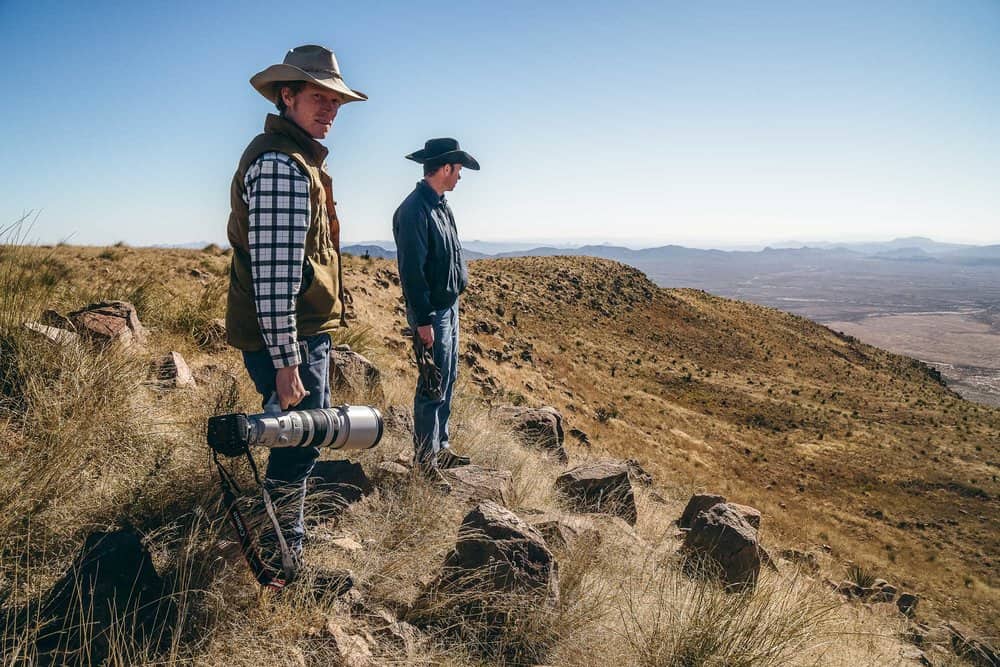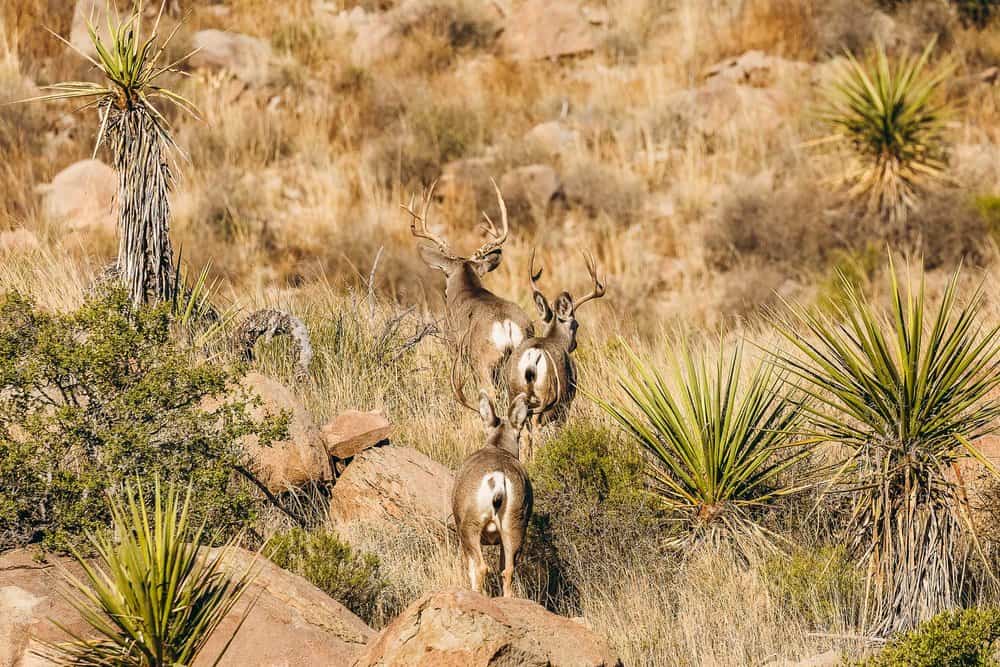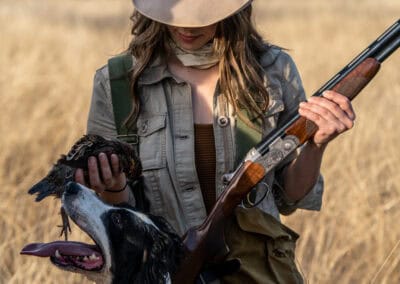Your cart is empty


A hot wind whisked across the boulder and cholla-laden slope of Elephant Mountain as the sounds of cloven hooves on stone trickled from the ridge below. At first, the big ram didn’t notice me, but as the wind changed, our eyes locked. Could he possibly understand his significance and that he was a key player in the salvation of desert bighorn sheep in the American West? As the seconds slowed to a crawl, I could see the wildness in his eyes and remembered that he was doing what millennia of evolution had trained him for: to thrive in a landscape more rugged and unforgiving than any I’d experienced on foot or horseback. This lone ram represented a half-century of successful conservation and the future of desert bighorn sheep reintroductions across a landscape once carved up by a legacy of exploitation. And in that very moment, the future of Texas desert bighorn sheep stared back at me, and then was gone before the blink of an eye, bounding down a field of car-sized boulders burnt under an autumn sun.
American conservationist Aldo Leopold, once said, “To keep every cog and wheel is the first precaution of intelligent tinkering.” By 1900, America’s ecological fabric had been largely dismantled as megafauna like bison, pronghorn, grizzly bears, and gray wolves had been slaughtered for the sake of blind progress at any expense. With a theological North Star guiding each stroke of the axe, westward expansion did away with each cog and wheel lacking a conspicuous and timely value deemed worthy as wagon ruts, barbed wire and train tracks cut up and spit out a once endless sea of American wilderness.
No ecological community was spared: passenger pigeons that clouded the heavens and provided the single largest dose of nutrients in North America no longer flooded eastern skies. Bison that roamed across the West in great herds extending 20 miles in all directions no longer punctuated a sea of perennial bunchgrasses and songbirds. Grasslands were converted to deserts with the loss of topsoil, rivers turned dry from the incessant pull of irrigation, riparian corridors vanished, and fertile forests that once housed mountain lion, bear and martin no longer supported the predators who shaped them and ensured their wellbeing. By 1900, a war had been waged on wilderness and the aqueous arteries that nourished them.
Far from the marbled halls of Washington D.C. where early conservationists like Gifford Pinchot and Teddy Roosevelt shaped legislation and a future for a select slice of America’s wilderness, the remote, wild and far-removed were largely left unmanaged at the mercy of our collective will to tame, transform, and unwild. This freedom to carve any signature a man deemed right and good into the land existed unbridled from Maine to Texas, Nevada to North Dakota.
As we peek into the rearview mirror of land-use and conservation in America, you’ll find few prejudices faded with the test of time. Yet, signs of intelligent tinkering and stewardship abound. One such example took us to the sun-kissed mountains of West Texas where a community of Texas Parks and Wildlife biologists, private landowners, conservationists and hunting organizations are working together to reintroduce desert bighorn sheep to a vast expanse of copper-toned wilderness that pours across Texas and Mexico beyond.

With the prospect of hiking and riding horseback through a West Texas wilderness home to one of the state’s source populations of desert bighorn sheep, I connected with conservation filmmaker, Ben Masters, to research a potential film on desert bighorn sheep conservation. So, we headed West to Elephant Mountain Wildlife Management Area and Big Bend Ranch State Park. We hopped in the back of a Texas Parks and Wildlife Ford F-150 and took the long road up the mesa of Elephant Mountain. Here we could access some of the more exposed vistas where, with keen eyes and a steady hand, we could catch a glimpse of a thriving desert bighorn sheep population, and plan our week ahead. Our guides, Texas Parks and Wildlife Biologists Mark Garrett and Dewey Stockbridge, explained the fascinating history of these animals while we drove.
Desert bighorn sheep, like other North American megafauna, were mostly wiped out across their historic range from habitat loss, introduced diseases, overhunting, and increased competition for forage with exotics like cattle, sheep and horses. By the early 1900s, Texas had nearly lost the last of its desert bighorn. Their numbers hovered around zero until the 1960s, when efforts to reintroduce them to remote patches of Texas wilderness — public and private — began to circulate through state and private constituents invested in the land’s ecological integrity, structure and function. In 1973, the first desert bighorn sheep reintroduction efforts took place in the Sierra Diablo Mountains. This herd steadily grew and was supplemented by captured-and-released sheep from Nevada, Arizona, and Mexico to avoid a genetic bottleneck. As the population grew, Texas Parks and Wildlife captured and released desert bighorn sheep into other remote mountain ranges that contained suitable habitat. One of those places, Elephant Mountain Wildlife Management Area—which was donated to Texas in 1985 — received bighorns in 1987. Since then, for reasons unknown, the desert bighorn sheep have thrived on Elephant Mountain better than other mountain ranges, transforming this herd into a vital source population for further reintroduction efforts. With 50 years of active management, conservation and reintroduction efforts, desert bighorn sheep populations have climbed from zero to over 1,000 individuals. It is a massive conservation success story, with forward momentum driving the reintroduction efforts slated in coming years.

As we stepped onto the brow of Elephant Mountain, we saw a world largely free from fences or any conspicuous signature of man: a vast expanse where 160 desert bighorn sheep responsible for seeding future populations throughout the state lived a wild existence. As we watched them leaping from rocky ledges through a cactus-strewn landscape, Dewey discussed the importance of “rewilding” landscapes near and far.
It’s fairly simple: to save desert bighorn sheep is to save an entire ecosystem. In the fields of ecology and conservation biology, these animals are called umbrella species because their salvation is inextricably bound to those of every fiber of flora and fauna that comprise the ecological fabric of the area. This notion of saving the top to protect the bottom has been employed across the globe with the protection and reintroduction of bison into the American West, wolves into Yellowstone National Park, sage grouse in the great sagebrush sea, and elephants in Chad’s Zakouma National Park.

After our morning scout with the TPW biologists, we set out to document and closely observe the desert bighorn sheep of Elephant Mountain. We made our way down the steep mountain roads, set up spotting scopes, and began searching behind every rock, cholla and yucca for the well-camouflaged sheep sleeping away the hot afternoon. As we scoured every visible inch of ground, I glanced downslope at just about eye level, and something caught my attention. About 500 yards away from us, at the bottom of the hill, a family of sheep stood frozen in the high noon wind.
They were hiding right in front of us. We slowly gathered our gear and hiked towards them. At fifty yards, it was clear that they were a bit nervous, so we slowed, then stopped our approach, hunkered down behind some yucca, and began taking photographs. Seemingly, with each passing moment they became more aware that we weren’t a threat, and over the course of an hour or so, we closed the gap, which offered a closer look into their simple but fascinating existence. For the rest of the day, we trailed them across Elephant Mountain. As we followed them through boulder feeds and stands of cholla, I reflected on the shift in value that society places on wildlife. There had been such a broad legacy of exploitation, which has been transformed into one of conservation. These sheep, the benefactors, have once again been given the room and space to call these rugged peaks of West Texas home. They’ve become the seed stock that will slowly recolonize pockets of their historical range.
Related Stories



Latest Stories


